
A free short adventure for four 4th-level characters by Mike Mearls Looking Glass Deep is a flexible, site-based scenario that presents you with the details of the ruined abode of the wizard Urlen Sparlek -- and the gang of outlaws that now occupies the place. This 10-page adventure by Mike Mearls is designed for 4th-level characters. Unlike some site-based scenarios, Looking Glass Deep features a dungeon full of monsters that take proactive steps to defeat the player characters (PCs). Tzarrik the hobgoblin sorcerer is an intelligent tactician with the ability to spy on the party almost at will when the group is within the Deep. His ragged gang of followers work together as a team under his command to repel attackers. Throughout the course of the adventure, the characters have the opportunity to locate an artifact called book the key of the way , discover the mysteries of the throne of the Deep -- and perhaps, in the end, even gain themselves a new headquarters.

Synopsis: Chalk Hill is a lonely village on the edge of the Downs. Nearby barrows contain remains of long-dead kings. As is the local custom, a pair of young newlyweds went to the ancient standing stones for the druids to bless their union. They never came back. The heroes must find and return the couple, who have been taken into the grave of Eorl Wulfstan. The undead Eorl saw the new-wife in a dream, and she is the spit of his long-lost beloved, so he had his servants bring her to him. They slew the young man, who rose as undead under the Eorl’s control. Can the heroes find the survivor and put the dead back to rest? A 4 to 6 hour adventure for 4 to 6 Tier 1 characters—optimized for 5 characters of 3rd level. This adventure came about thanks to the generosity and encouragement of Dyson Logos, cartographer of Waterdeep: Dragon Heist. In it you'll find maps never before seen in a Guild adventure! "Chalk Hill" is an Old School "out and down" dungeon crawl, where brave adventurers venture into the wilderness and pit themselves against horrors which would set a-quiver the flesh of honest folk. It's proof you can have an OSR experience using the 5e rules!

While you search for treasure, others search for you. A treasure vault without guards or traps - can it be true? Pgs. 16-30
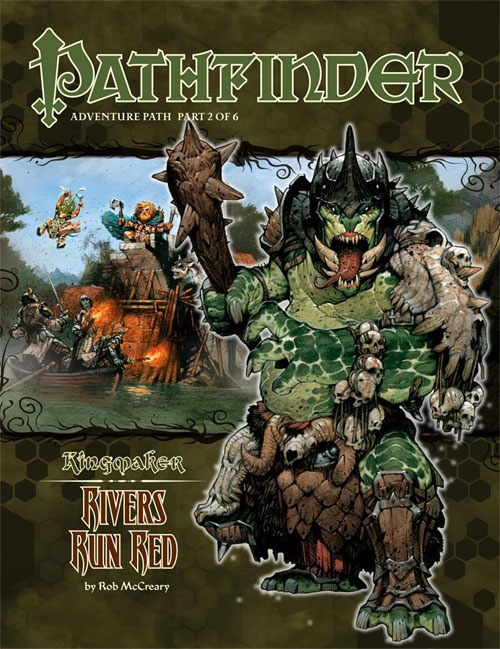
A Pathfinder Roleplaying Game adventure for 4th-level characters, this volume of Pathfinder Adventure Path is part 2 of 6 of the Kingmaker Adventure Path, in which the heroes win and defend a small kingdom from threats foreign and domestic. PCs should advance to 7th level by the end of this adventure. The PCs receive a shipment of funds, materials, and colonists from Brevoy and beyond, along with instructions to build a town and attract more pioneers to their nascent country. Having already explored the northern reaches of their new domain, the PCs must now venture into the wilds to bring the rule of law to the south. Wicked fey inhabiting a ruined keep, undead haunting an ancient barrow mound, and others must be defeated to make the region ever more secure. Along the way, the PCs might also have the opportunity to ally themselves with some of the region’s local residents, including the dryad druid Tiressia, her satyr consort Falchos, and a band of gnome explorers called the Narthropple Expedition. In addition, the PCs will be called upon to mediate between two rival factions in the area: a group of independent loggers and the angry fey sorceress who opposes them. As they explore, evidence that a group of trolls is stirring up trouble in the region becomes apparent. Meanwhile, the PCs must deal with events within their burgeoning kingdom—a rabble rouser seeks to oust the PCs from their positions of power, the secretive cult of the hag goddess Gyronna has infiltrated the town, and a werewolf is preying on the townsfolk. All of these events build to the adventure’s twin climaxes: the sudden assault on their capital city by an owlbear of unprecedented size and the expansion of Hargulka’s trolls into the north. Faced with danger on multiple fronts, the PCs must draw upon all of their resources and bravery to become the undisputed rulers of the Greenbelt.

Off in the wilderness are the ruins of a temple that once belonged to the God of Balance, Tyr. It has long been abandoned by the traditional followers, but it is certainly not empty. A few clever individuals have found a way to harness the magics that still reside deep within this holy place and are attempting to use it to give life to an Iron Golem. The party must stop them at all costs or have a powerful monstrosity released into the hands of some terrible individuals.

Warchief Grog Bloodloaf has sounded the horn of war. Elf scum have stolen orc lands and the tasty halfling herds. For generations the Maggotsmasher Clan has watched and waited from the icy caves of the frozen mountains but that wait is over. Warchief Bloodloaf needs only the totem of leadership, the Dragon Crown of Durge Maggotsmasher, to unite the clans and begin his war. Five misfits have answered the call to brave the Caves of Throllorat and return with the crown. With a little luck, these five maggots will kill a few of the beasts within Throllorat before dying, making it easier for real warriors to complete the quest. The Misfit Maggot Five is a comdedic adventure where five rejects from the Maggotsmasher Clan are called upon to retrieve the famed Dragon Crown of Durge Maggotsmasher from the dreaded caves of Throllorat. Each of the characters are fully developed with their own unique personality that will give any Dungeons and Dragons group hours of laughs! The Misfit Maggot Five is a 5th edition comedy adventure for 2nd level monstrous humanoid characters. Published by The Pickled Dragon Press

The time has come to venture beyond the village of Orașnou and explore the realm of Barovia. However, in your travels, you happen across an unusual tribe of peopl —distrusted denizens of the Demiplane of Dread. Do the Vistani truly possess the ability to see the future, or is it simple parlor tricks and deceit? Part Five of Misty Fortunes and Absent Hearts.
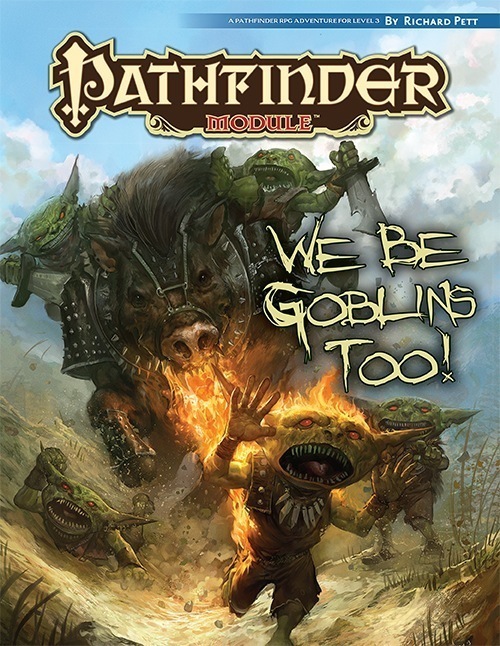
The Licktoads, once the great and fierce goblin tribe in Brinestump Marsh, were defeated by human adventurers! All that remains of the tribe are its four goblin "heroes". Homeless and bored, they left their swampy homeland to join the neighboring goblin tribe, the Birdcrunchers. The good news is that the Birdcrunchers are willing to let the goblin heroes join their tribe. The better news is that the Birdcrunchers have heard of these four, and want one of them to become their new chieftain. The bad news is that before the goblins can join, they'll need to endure a series of dangerous and humiliating tests. Very dangerous. Very humiliating. The worse news is that lately Birdcruncher chieftains have had really short lifespans—they're being killed by the pet fire-breathing boar of a local ogre who wants the Birdcruncher land as his own. Part 2 of the We Be Goblins series.

Nobody complained when the raids by goblins stopped. Until word got around that the monsters had been slain by other monsters! Our heroes have been sent to investigate and remove any remaining threat. Published by Fortiter Games.

Eons-old secrets slumber beneath the forbidden Ghost Ice. Since the time of the Elders, the local tribes have shunned the crawling glacier, knowing it as taboo land that slays all who tread its frigid expanse. Now, the Ghost Ice has shattered, revealing hints at deeper mysteries entombed within its icy grasp. Strange machines and wonderful horrors stir beneath the ice… Frozen in Time is a level 1 adventure for any DCC RPG campaign. It also includes new material for judges who want to send their adventurers in a Stone Age setting!

The Characters come across an ancient wizard's tower. The nearby keep has been reduced to rubble over the ages, but the tower is in perfect condition. It is surrounded by an impenetrable force field that cannot be breached - not even by the ghost of the long-dead wizard, who has been trapped within for centuries. Surely there must be great treasure within this magical abode. But how to get to it?

Not even memories of past glory live on in the gentle hills around the village of Kusnir. Today its people have more concern for commonplace things, like the harvest, trade, and the threat of death in the night! Kusnir is beset by a skulk. The attentions of such a creature are a curse on any community. Streets and alleys which ring to the voices of children by day become fearful, shadowy places by night. Men go abroad armed and in groups, while women and children stay behind locked doors and even there are not safe. But life goes on. The lot of the peasant is always hard, what cannot be prevented must be endured and, of course, things could be worse. Much worse. The skulk has begun to visit the village more and more often. Sometimes it kills, yet just as often it spares a victim, leaving clear signs of what it might have done had it wished. Its visits are now marked by strange and illegible symbols scrawled in blood on the walls of the buildings. The people are worried, helpless, and desperate. Desperate enough to welcome adventurers. UK2: "The Sentinel" (1983) is the second UK-series adventure, the fifth TSR UK adventure overall, the first solo effort by Morris, and the first half of the two-part Adlerweg series (whew!). It was run as a tournament at the GamesFair '83 Open, then published later in 1983. TSR 9101
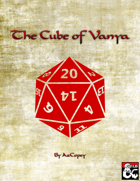
Inspired by the "Happy Fun Ball" from the web series Critical Role, The Cube of Vanya is a magical adventure through demi-planes created by an ancient wizard, now destabilized by a malevolent dragon. The adventurers find themselves trapped within a series of themed planes with no idea how they got there. Navigating these planes to find a means of escape, they uncover the secrets of the cube while piecing back together their own memory. During the campaign the adventurers may fight shadow demons in an inn which is really a prison, flee a tornado while perched perilously in the sky, forge a weapon within a volcano, and much more. The module is structured in a non linear manner allowing the adventurers to choose their own way, or for the DM to pick and choose their favourite bits to highlight. The adventure was written with four level 5 players in mind but it would be easy to tweak for different sized groups around that level.

Hunt for the Thessalhydra is a short adventure published by Wizards of the Coast as a tie in to the "Stranger Things" franchise and part of the Stranger Things Dungeons & Dragons Starter Set. The adventure features characters, locations, and monsters inspired by that series. The adventure is suitable for characters of level 3-5.
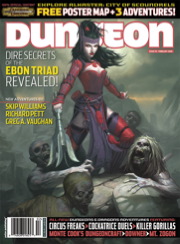
The sleepy forest town of Aulbesmil has seen better days. Orcs and monsters lurk in the woods now, but the real menace hides in the town itself. The PCs arrive in town to investigate a mysterious tragedy that has befallen the townsfolk. As they explore the town, they learn of other strange happenings and must assemble the puzzle to figure out who is responsible for the thefts and disappearances. Eventually, they track down the baron's culprit and bring him to justice, as well as liberate the captive nephew of the Baron. Pgs. 16-28
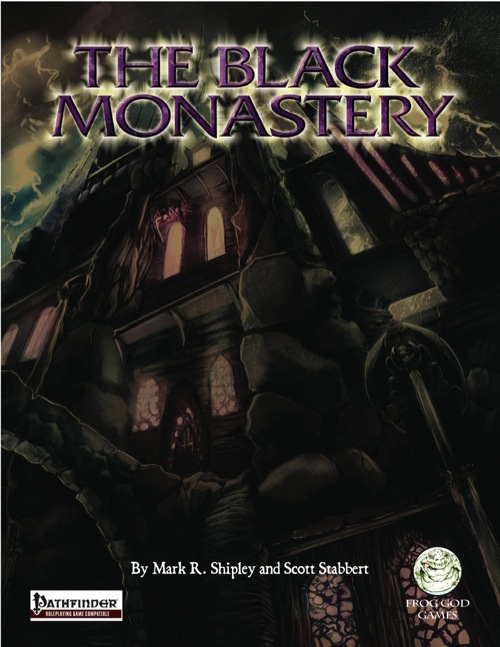
The Legend of the Black Monastery Two centuries have passed since the terrible events associated with the hideous cult known as the Black Brotherhood. Only scholars and story-tellers remember now how the kingdom was nearly laid to waste and the Black Monastery rose to grandeur and fell into haunted ruins. The Brothers first appeared as an order of benevolent priests and humble monks in black robes who followed a creed of kindness to the poor and service to the kingdom. Their rules called for humility and self denial. Other religious orders had no quarrel with their theology or their behavior. Their ranks grew as many commoners and nobles were drawn to the order by its good reputation. The first headquarters for the order was a campsite, located in a forest near the edge of the realm. The Brothers said that their poverty and dedication to service allowed them no resources for more grand accommodations. Members of the Black Brotherhood built chapels in caves or constructed small temples on common land near villages. They said that these rustic shrines allowed them to be near the people they served. Services held by the Brothers at these locations attracted large numbers of common people, who supported the Black Brotherhood with alms. Within 50 years of their first appearance, the Black Brotherhood had a number of larger temples and abbeys around the kingdom. Wealthy patrons endowed them with lands and buildings in order to buy favor and further the work of the Brothers. The lands they gained were slowly expanded as the order’s influence grew. Many merchants willed part of their fortunes to the Black Brotherhood, allowing the order to expand their work even further. The Brothers became bankers, loaning money and becoming partners in trade throughout the kingdom. Within 200 years of their founding, the order was wealthy and influential, with chapters throughout the kingdom and spreading into nearby realms. With their order well-established, the Black Brotherhood received royal permission to build a grand monastery in the hill country north of the kingdom’s center. Their abbot, a cousin of the king, asked for the royal grant of a specific hilltop called the Hill of Mornay. This hill was already crowned by ancient ruins that the monks proposed to clear away. Because it was land not wanted for agriculture, the king was happy to grant the request. He even donated money to build the monastery and encouraged others to contribute. With funds from around the realm, the Brothers completed their new monastery within a decade. It was a grand, sprawling edifice built of black stone and called the Black Monastery. From the very beginning, there were some who said that the Black Brotherhood was not what it seemed. There were always hints of corruption and moral lapses among the Brothers, but no more than any other religious order. There were some who told stories of greed, gluttony and depravity among the monks, but these tales did not weaken the order’s reputation during their early years. All of that changed with the construction of the Black Monastery. Within two decades of the Black Monastery’s completion, locals began to speak of troubling events there. Sometimes, Brothers made strange demands. They began to cheat farmers of their crops. They loaned money at ruinous rates, taking the property of anyone who could not pay. They pressured or even threatened wealthy patrons, extorting money in larger and larger amounts. Everywhere, the Black Brotherhood grew stronger, prouder and more aggressive. And there was more… People began to disappear. The farmers who worked the monastery lands reported that some people who went out at night, or who went off by themselves, did not return. It started with individuals…people without influential families…but soon the terror and loss spread to even to noble households. Some said that the people who disappeared had been taken into the Black Monastery, and the place slowly gained an evil reputation. Tenant farmers began moving away from the region, seeking safety at the loss of their fields. Slowly, even the king began to sense that the night was full of new terrors. Across the kingdom, reports began to come in telling of hauntings and the depredations of monsters. Flocks of dead birds fell from clear skies, onto villages and city streets. Fish died by thousands in their streams. Citizens reported stillborn babies and monstrous births. Crops failed. Fields were full of stunted plants. Crimes of all types grew common as incidents of madness spread everywhere. Word spread that the center of these dark portents was the Black Monastery, where many said the brothers practiced necromancy and human sacrifice. It was feared that the Black Brotherhood no longer worshipped gods of light and had turned to the service of the Dark God. These terrors came to a head when the Black Brotherhood dared to threaten the king himself. Realizing his peril, the king moved to dispossess and disband the Black Brother hood. He ordered their shrines, abbeys and lands seized. He had Brothers arrested for real and imagined crimes. He also ordered investigations into the Black Monastery and the order’s highest ranking members. The Black Brotherhood did not go quietly. Conflict between the order and the crown broke into violence when the Brothers incited their followers to riot across the kingdom. There were disturbances everywhere, including several attempts to assassinate the king by blades and by dark sorcery. It became clear to everyone that the Black Brotherhood was far more than just another religious order. Once knives were drawn, the conflict grew into open war between the crown and the Brothers. The Black Brotherhood had exceeded their grasp. Their followers were crushed in the streets by mounted knights. Brothers were rounded up and arrested. Many of them were executed. Armed supporters of the Black Brotherhood, backed by arcane and divine magic, were defeated and slaughtered. The Brothers were driven back to their final hilltop fortress – the Black Monastery. They were besieged by the king’s army, trapped and waiting for the king’s forces to break in and end the war. The final assault on the Black Monastery ended in victory and disaster. The king’s army took the hilltop, driving the last of the black-robed monks into the monastery itself. The soldiers were met by more than just men. There were monsters and fiends defending the monastery. There was a terrible slaughter on both sides. In many places the dead rose up to fight again. The battle continued from afternoon into night, lit by flames and magical energy. The Black Monastery was never actually taken. The king’s forces drove the last of their foul enemies back inside the monastery gates. Battering rams and war machines were hauled up the hill to crush their way inside. But before the king’s men could take the final stronghold, the Black Brotherhood immolated themselves in magical fire. Green flames roared up from the monastery, engulfing many of the king’s men as well. As survivors watched, the Black Monastery burned away, stones, gates, towers and all. There was a lurid green flare that lit the countryside. There was a scream of torment from a thousand human voices. There was a roar of falling masonry and splitting wood. Smoke and dust obscured the hilltop. The Black Monastery collapsed in upon itself and disappeared. Only ashes drifted down where the great structure had stood. All that was left of the Black Monastery was its foundations and debris-choked dungeons cut into the stones beneath. The war was over. The Black Brotherhood was destroyed. But the Black Monastery was not gone forever. Over nearly two centuries since its destruction, the Black Monastery has returned from time to time to haunt the Hill of Mornay. Impossible as it seems, there have been at least five incidents in which witnesses have reported finding the Hill of Mornay once again crowned with black walls and slate-roofed towers. In every case, the manifestation of this revenant of the Black Monastery has been accompanied by widespread reports of madness, crime and social unrest in the kingdom. Sometimes, the monastery has appeared only for a night. The last two times, the monastery reappeared atop the hill for as long as three months…each appearance longer than the first. There are tales of adventurers daring to enter the Black Monastery. Some went to look for treasure. Others went to battle whatever evil still lived inside. There are stories of lucky and brave explorers who have survived the horrors, returning with riches from the fabled hordes of the Black Brotherhood. It is enough to drive men mad with greed – enough to lure more each time to dare to enter the Black Monastery.

Wherein the Heroes step through a Portal to find themselves in a Location Most Foul, from which they make their Entrance into the infinite Planes of Adventure. Chapter I of the "Well of Worlds" adventure anthology.

From The Magazine: "Every summer, Duke Hightower holds a competition quite different from the traditional jousting and archery tournaments held by similar lords of his station. The rules of his tournament change from year to year, and, to oversee the games, the duke has appointed two wizard brothers who help choose the setting and create the rules and challenges of the competition. This year the competition is called the “Owlbear Run,” an overland race that requires each participating team to escort a live owlbear from the town of Telvorn to the town of Milvorn. The teams will face a variety of challenges; some are devised by the wizards, others by the competing teams or their sponsors, and some occur entirely at random. All of these tests are in addition to the challenges inherent in motivating a temperamental owlbear. Fortune and fame await the first team to cross the finish line, and the local lords sponsoring the race are eager to enlist skilled champions for their causes." Pgs. 2-27

In this level 6 adventure for 4-6 players the party comes across a man named Johann Dhomm who was transporting animals in cages to his private island where he has a menagerie (a kind of zoo) that he eventually wants to open to the public. But the animals have escaped and he asks the party to try and catch them alive for him. However, the animals are actually quite dangerous and range from Gazers to a Wyvern.
A pair of leprous mountain dwarves plead for the rescue of their compatriots from a deadly ettin-wight